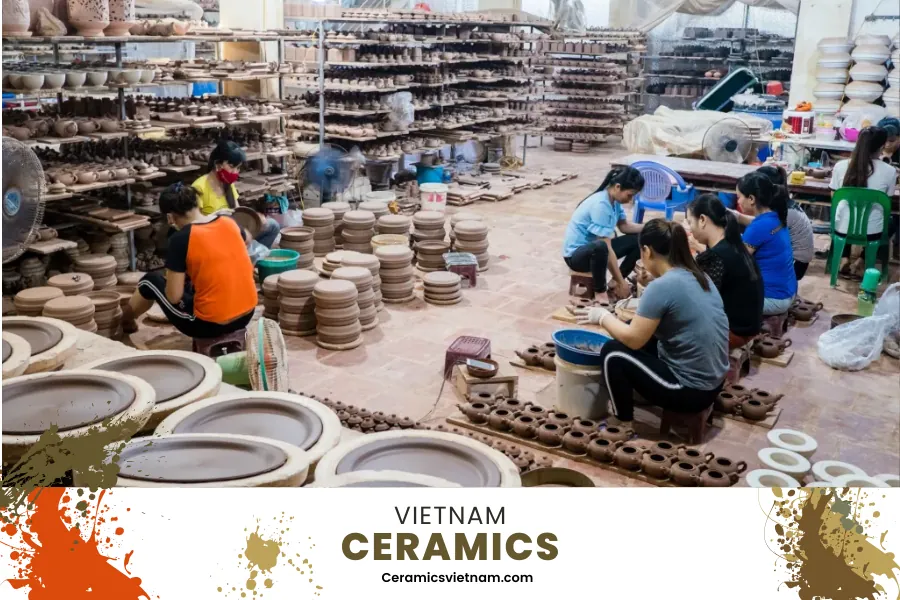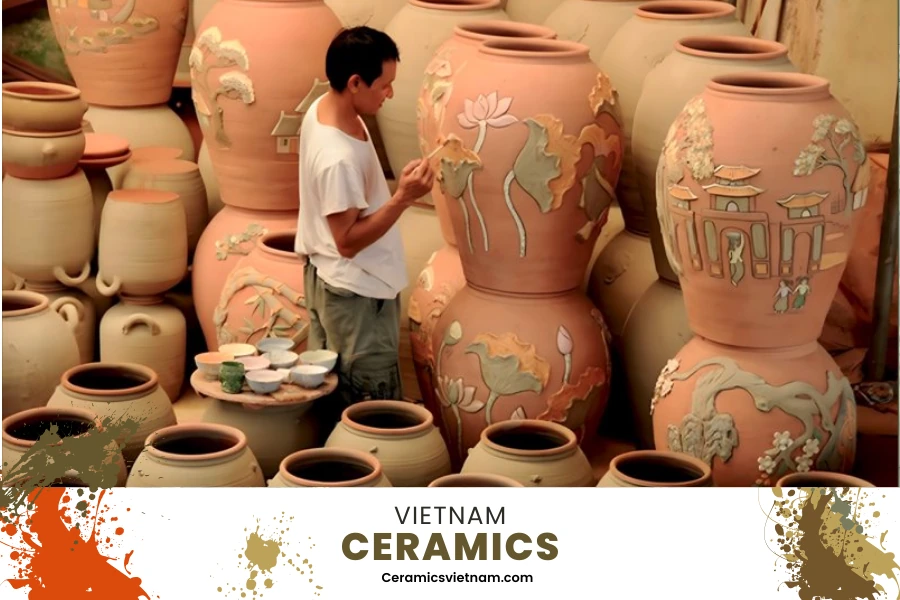Nestled on the banks of the Red River in Vietnam, Bat Trang Pottery Village has long been celebrated for its exquisite ceramic craftsmanship. Renowned for its rich history and tradition, Bat Trang Pottery has earned a distinguished place in the world of artisanal ceramics. Join us on a journey to explore the artistry and heritage that define this charming pottery village. Welcome to the enchanting world of Bat Trang Pottery.
Introduction to Bat Trang Pottery Village

Introducing Bat Trang Pottery
Bat Trang Pottery Village, situated in Bat Trang commune, Gia Lam district, Hanoi, Vietnam, is comprised of two hamlets, namely Bat Trang and Thon Giang Cao. The entire commune covers an area of 164.3 hectares, with 43 hectares designated as residential land. Within the narrow 18-hectare space, 753 households from Bat Trang Village reside, including 5.3 hectares of residential land belonging to the ancient Bat Trang Village.
Bat Trang Village is an artisanal craft village specializing in Bat Trang Pottery. The village’s pottery craft has a long and storied history, enduring and evolving over centuries. While a comprehensive scientific study on the village and pottery craft is yet to be conducted, it is certain that the pottery craft predates the establishment of Bat Trang Village. The forebearers of Bat Trang brought the pottery craft to a place with 72 white clay mounds called Bach Tho Phuong, where they established kilns and founded the village. In this new homeland, the craft and the village became synonymous and gained fame as Bat Trang Pottery.
According to oral traditions passed down through generations, after the Lý Dynasty moved the capital from Hoa Lu to Dai La and renamed it Thang Long, artisans and craftsmen of pottery from villages like Vinh Ninh Trang, Bo Xuyen, and Bach Bat (Thanh Hoa-Ninh Binh) were permitted by the king to come to Bach Tho Phuong. There, they established kilns, founded the village, and produced pottery and bricks for the feudal state. Over several generations, Bach Tho Phuong evolved into Bat Trang Village.
The genealogy of many lineages in Bat Trang vividly records the migration of the pottery craft to Bach Tho Phuong. The migration from the old homeland to the new one occurred over many centuries, reaching its peak during the late 14th century of the Tran Dynasty and the Le Dynasties. By this time, Bat Trang had 20 lineages with the same homeland, the same craft, settling in the new homeland.
Architectural structures in the village, such as communal houses, temples, pagodas, and steles, reflect the history of the village and the craft, documenting the migration from the old homeland to Bat Trang. For instance, at the communal house of Bat Trang Village, 44 royal edicts from various dynasties in Vietnamese feudal history are preserved, conferring divine authority upon the village and illustrating aspects of the craft’s migration, as seen in inscriptions like:
“Bồ di thủ nghệ khai đình vũ
Lan nhiệt tâm hương bái thánh thần”.
This translates to the artisans bringing the craft from Bo village, constructing a communal house, and the villagers respectfully offering incense to the deities.
Another inscription reads: “Bạch Bát chân truyền nê tác bảo
Hồng lô đào chú thổ thành kim”
This means that the pottery craft is passed down from Bach Bat, solidified in the kilns’ fire, and the clay transforms into a durable material.
A notable feature is the inclusion of the highest-ranked deity, Bach Ma Dai Vuong, the guardian deity of Thang Long, worshipped at the Bach Ma Temple (Hang Buom). This temple is one of the four main guardian temples of Thang Long – Hanoi.
According to official history, the name Bat Trang first appeared in the “Dai Viet Su Ky Toan Thu” during the Tran Dynasty’s reign over feudal Dai Viet. Therefore, by the 14th century, the name Bat Trang Village was already present in the official historical records of the feudal state, gaining fame not only for its historical significance but also for its pottery craft. Certainly, the village must have endured and developed over a very long period.
The term “Bach Tho Phuong” translates to the white clay precinct, a place chosen by the ancestors of present-day Bat Trang to establish kilns, found the village, and produce pottery for the state. Thus, the history of the pottery craft and the village of Bat Trang are closely intertwined.
Bat Trang’s pottery products are diverse, ranging from bricks to ceramics, all crafted from the same raw material, clay. Bat Trang bricks, renowned before the ceramics, are immortalized in Vietnamese folk sayings like:
“Ước gì anh lấy được nàng
Để anh mua gạch Bát Tràng về xây”
Means
“I wish you could marry her
So I could buy Bat Trang bricks to build.”
Bat Trang bricks are still present in the architectural structures of Thang Long Imperial City, Temple of Literature, communal houses, temples, pagodas, lakes, and wells in villages throughout Vietnam. They are most abundant in Hue Imperial City and the mausoleums of the Nguyen Dynasty kings.
Alongside Bat Trang bricks, Bat Trang ceramics are equally famous nationally and internationally. Bat Trang ceramics come in various styles, types, sizes, and functions, including ritual items like incense burners, lamp bases, candle holders, altar vases, liquor vessels, and more. Handcrafted on a potter’s wheel in the traditional method of coiling, the ceramics have a thick structure. Later, the technique of printing on wooden molds and casting in plaster molds was introduced. With glazes like blue, brown, and crackle characteristic of Bat Trang ceramics, adorned with decorative patterns such as flowers, leaves, vines, and phoenixes, each product is tailored to its specific purpose.
The ancient Bat Trang ceramics are preserved and exhibited in numerous museums both domestically and internationally, cherished by antique collectors, possessing significant value in the market.
With a legacy spanning thousands of years, Bat Trang ceramics are no stranger to domestic consumers and the international market. Today, the Bat Trang craft village has transitioned into a new era of prosperity. Bat Trang ceramics have been exported to Europe, America, Taiwan, South Korea, and Japan. Over 50 companies and nearly 700 households engage in ceramic production and business. Some enterprises achieve annual export revenues of up to one million USD. Presently, Bat Trang Village focuses on development not only in ceramics and bricks but also as a tourist craft village, becoming an attractive destination for domestic and international tourists. With policies supporting tourism development and infrastructure, Bat Trang is gradually transforming into a modern, thriving village.
Introduction to Bat Trang Pottery craft

Introducing Bat Trang Pottery
Bat Trang Pottery, a dual-named term, reflects the artisanal craft of pottery combined with a geographical location – Bat Trang. Located in Gia Lam district, Hanoi, Bat Trang has been associated with pottery since the 15th century, dating back to the year 1010 when King Ly Thai To moved the capital from Hoa Lu (Ninh Binh) to Thang Long (Hanoi). Thang Long became the political, economic, and cultural center of the country, attracting numerous traders and craftsmen from various regions to establish their livelihoods. As Thang Long expanded, several suburban villages also developed economically, among them being Bat Trang. Situated near the capital and along the Red River, Bat Trang had favorable transportation conditions for the development of trade and industry, particularly due to the abundance of white clay in the region. According to local residents, there were 72 white clay mounds in Bat Trang, providing an excellent raw material source for pottery production.
The term “Bat Trang Pottery” encompasses various ceramic products manufactured in Bat Trang Village, located in Bat Trang commune, Gia Lam district, Hanoi. In Sino-Vietnamese characters, the word “Bat” (鉢) refers to the alms bowl of a monk (in Pali, it is Patra), while “Trang” (場, also pronounced as Truong) means “large courtyard,” signifying a specialized area. According to elders in the village, the character “Bat” on the left consists of the radical “Kim-金,” representing wealth, and “Bản-bản” means roots or origin. Using the characters “Bat” in this way serves as advice to future generations, encouraging them to remember their roots even when engaged in a trade or profession. Today, the characters “Bat Trang” are still inscribed in Han characters (鉢場) at various temples and shrines in Bat Trang.
Bat Trang is an ancient and renowned pottery village with rich cultural traditions, reflecting both the communal aspects of Northern Vietnam’s villages and the unique characteristics of the pottery craft. In this village, people of all ages are engaged in work, with few children seen playing in the streets. The skilled elderly artisans work tirelessly, either at the pattern-making table or at the glowing kilns. Women are involved in various stages of the production process, such as shaping, drying, and firing. Each stage demands multiple tasks, requiring technical and artistic expertise. The products of Bat Trang reflect the culmination of diligent labor, skillful hands, and artistic sensibilities. The people of Bat Trang, by preserving their craft and valuable heritage, passionately innovate to create ceramic products that are pure works of art and vibrant expressions of their cultural identity.
The process of making Bat Trang pottery

Introducing Bat Trang Pottery
For those interested in ceramic art and seeking a deeper understanding of the Bat Trang pottery craft village, we can focus on one of its most outstanding products – the Bat Trang teapot and tea cup set.
In Bat Trang, the production process of the Bat Trang teapot and tea cup set is a labor of love, requiring the dedication, technical expertise, and creativity of local artisans. Using high-quality raw materials such as the renowned white clay from the region, craftsmen create unique and exquisite teapot and tea cup sets.
The production process begins with the careful selection of raw materials, where high-quality white clay is chosen to ensure the final product’s quality. Subsequently, craftsmen use manual pottery wheels to shape the teapot and tea cups, each piece bringing its own elegance and uniqueness.
Once the shapes are perfected, the teapot and tea cups undergo drying and glazing, with multiple layers of colorful glaze creating intricate and sophisticated patterns. The firing process is then carried out in high-temperature kilns, resulting in teapot and tea cup sets that are both robust and highly durable.
These Bat Trang teapot and tea cup sets are not just traditional products but also symbols of refinement and class. With traditional patterns and designs, these sets are not only practical utensils but true works of art.
Introducing and sharing the Bat Trang teapot and tea cup sets is not just a way to promote the Bat Trang pottery brand but also a means to honor and preserve the cultural heritage of this craft village. Through these efforts, we can help elevate the Bat Trang craft village to become a cultural and artistic icon of Vietnam on the world map














Leave a reply